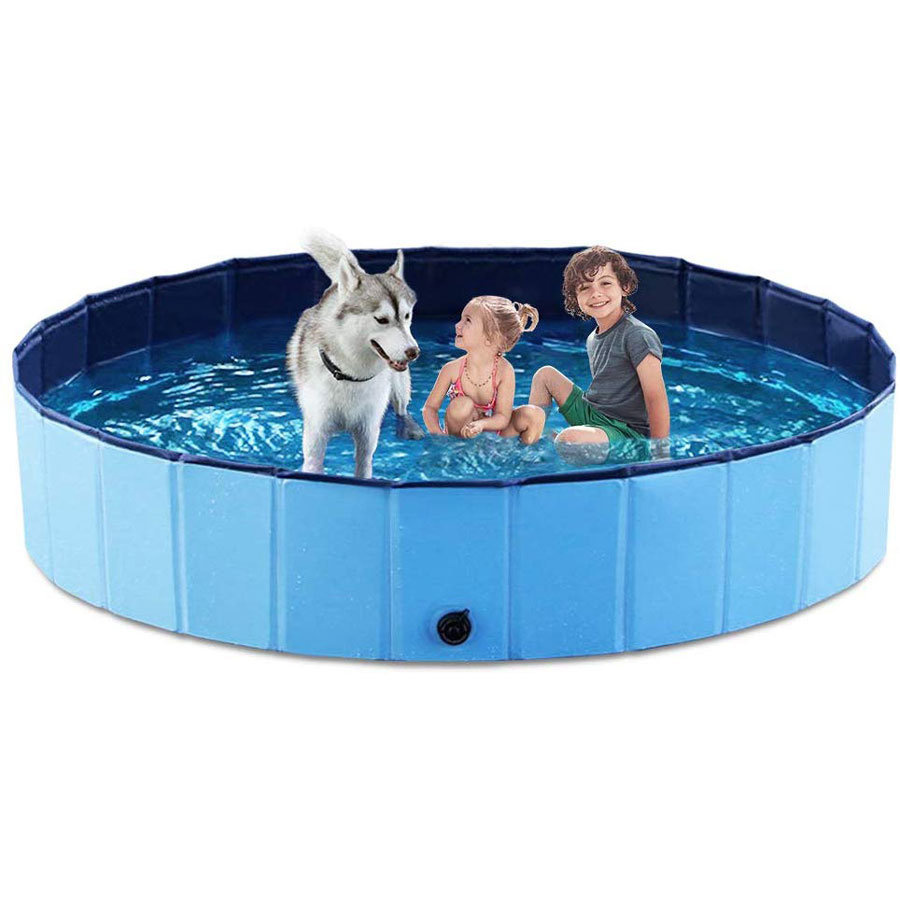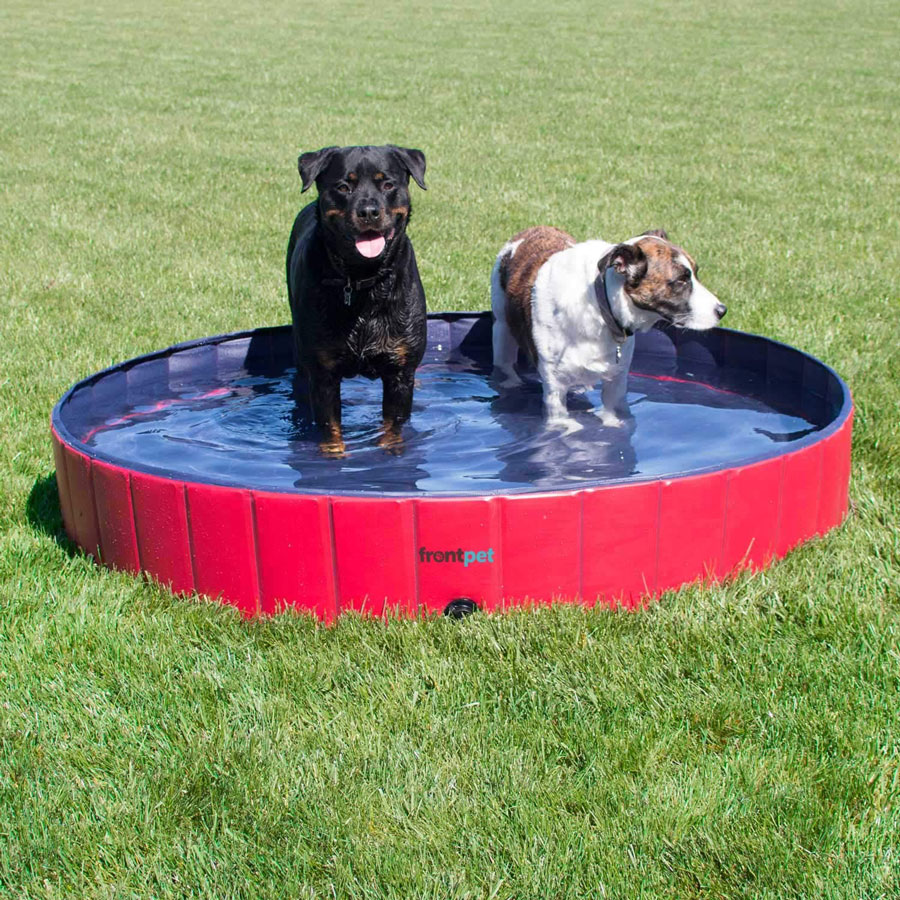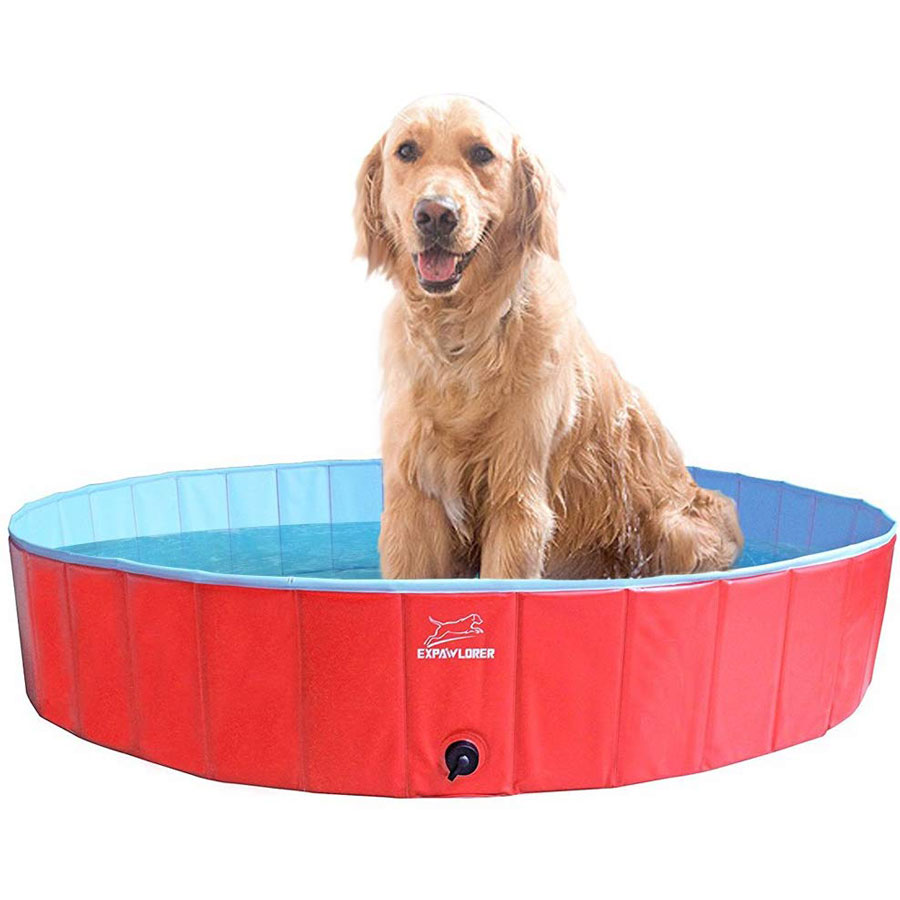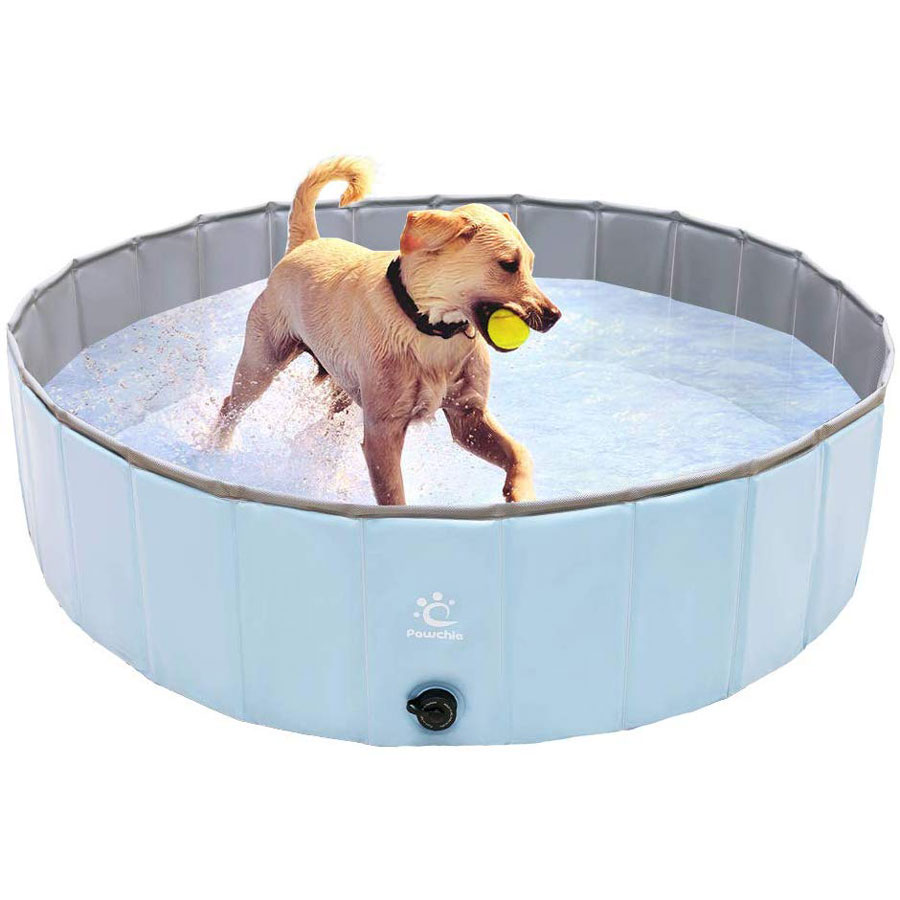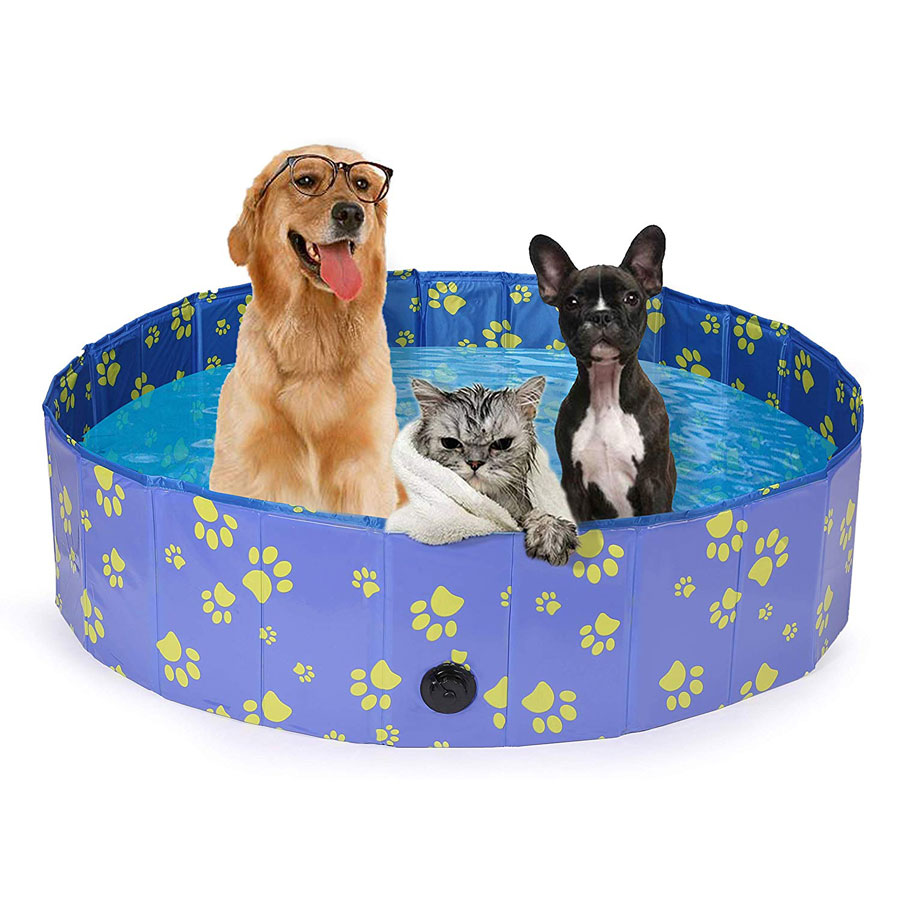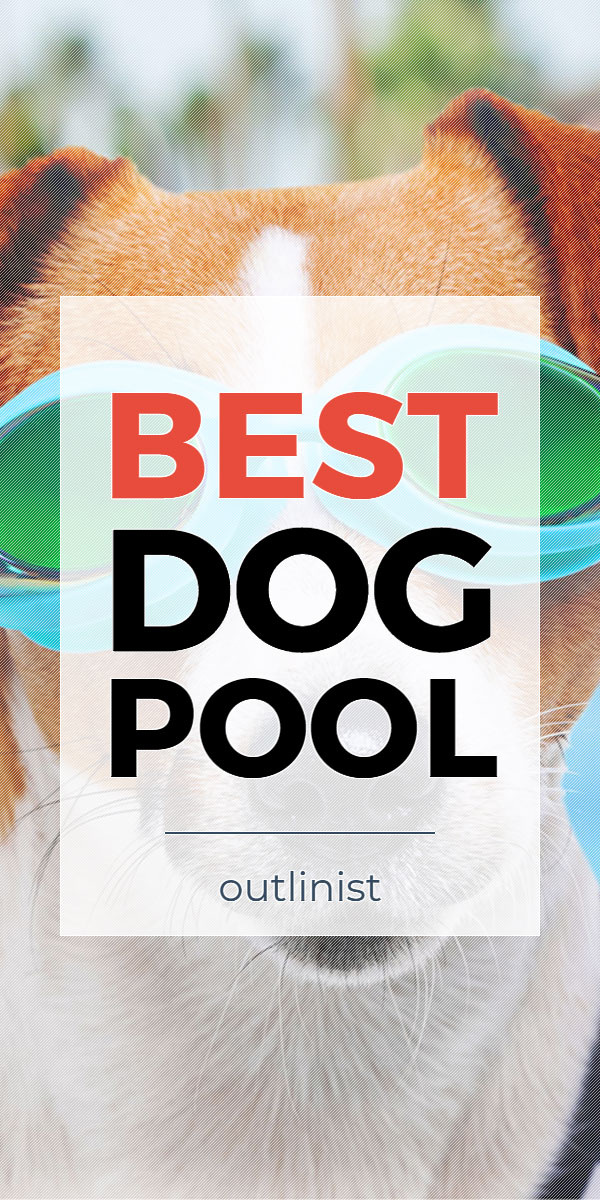
After 39 hours spent researching the best dog pools, we think Jasonwell Foldable Dog Pool is the best for most people.
This choice is based on several criteria: brand, type, dimensions, depth, material, color, drain, durable, portable, inflatable, easy installation, easy storage, easy cleaning, slip resistant, and weight, among other things.
| Product | Price | Overall Rating | Quality | Durability | Appearance | Maintenance | Value for Money | brand | type | dimensions | depth | material | color | drain | durable | portable | inflatable | easy installation | easy storage | easy cleaning | slip resistant | weight | |
|---|---|---|---|---|---|---|---|---|---|---|---|---|---|---|---|---|---|---|---|---|---|---|---|
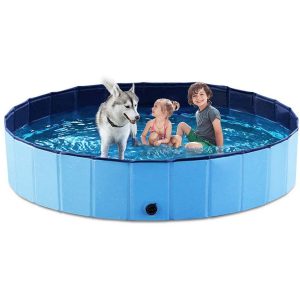 | Jasonwell Foldable Dog Pool | Check Price | 4.9 | 5.0 | 5.0 | 5.0 | 4.5 | 5.0 | Jasonwell | Round | 31 to 63 in | 8 to 12 in | PVC | Blue | 1 side | Yes | Yes | No | Yes | Yes | Yes | Yes | 16 lbs |
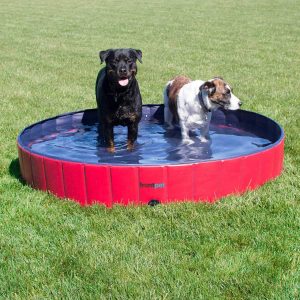 | FrontPet Foldable Dog Pool | Check Price | 4.8 | 5.0 | 5.0 | 4.5 | 4.5 | 5.0 | FrontPet | Round | 32 to 60 in | 8 to 12 in | PVC | Blue | 1 side | Yes | Yes | No | Yes | Yes | Yes | Yes | 16.5 lbs |
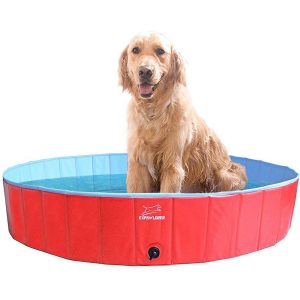 | Expawlorer Foldable Dog Pool | Check Price | 4.5 | 5.0 | 4.5 | 4.5 | 4.0 | 4.5 | Expawlorer | Round | 48 to 63 in | 12 in | PVC | Blue | 1 side | Yes | Yes | No | Yes | Yes | Yes | Yes | 15.1 lbs |
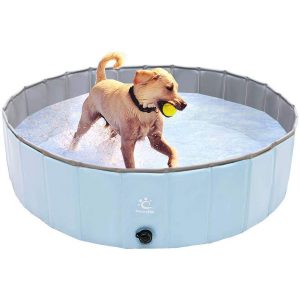 | Pawchie Collapsible Dog Pool | Check Price | 4.3 | 4.5 | 4.0 | 4.5 | 4.0 | 4.5 | Pawchie | Round | 47 in | 12 in | PVC | Blue / Pink | 1 side | Yes | Yes | No | Yes | Yes | Yes | Yes | 10.6 lbs |
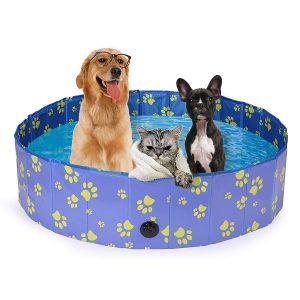 | Pro Goleem Foldable Dog Pool | Check Price | 4.2 | 4.5 | 4.0 | 4.0 | 4.5 | 4.0 | Pro Goleem | Round | 24 to 77 in | 8 to 12 in | PVC | Blue | 1 side | Yes | Yes | No | Yes | Yes | Yes | Yes | 6.1 lbs |
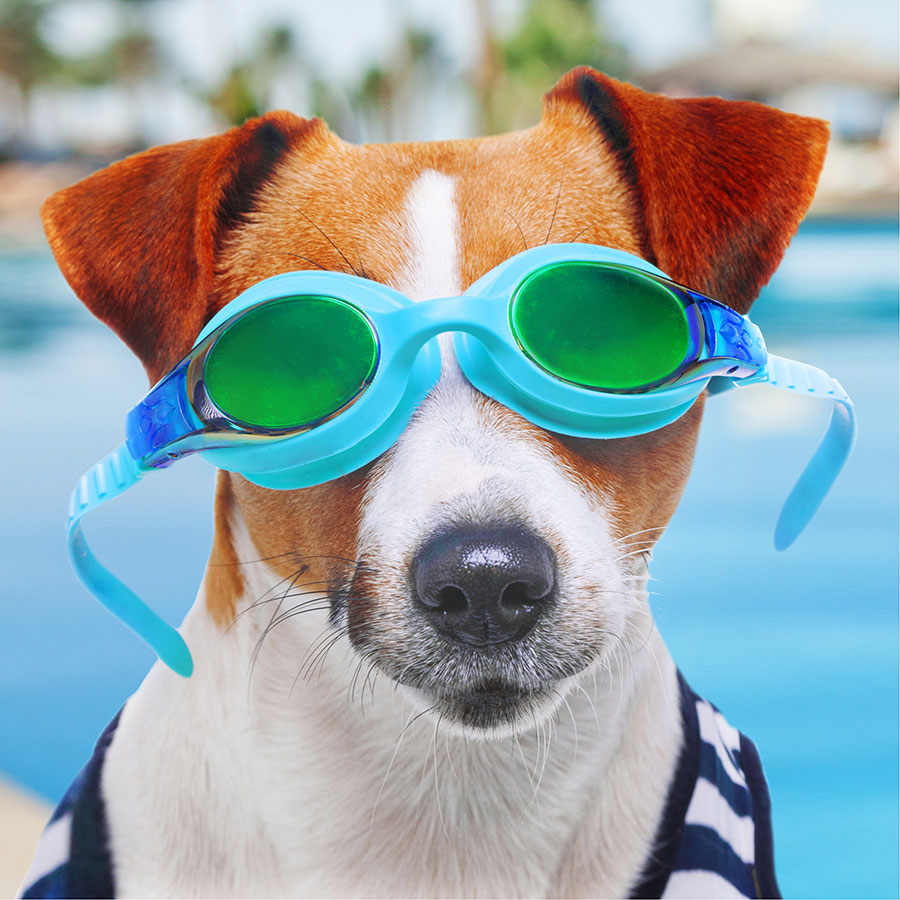
There are few things that will make your dog happier on a hot summer day than jumping into the best dog pool.
It’s not just Labradors and Portuguese Water Dogs that love water. Dogs of all sorts appreciate cooling down in a pool.
Providing for your furry friend is serious business, even it involves the use of fun toys like an automatic dog ball launcher or a dog agility tunnel, or spending time choosing the best dog interactive toy to stimulate their brain.
Some dogs require a bit more care, like an automatic dog feeder with portion control for diet issues, or a dog anxiety jacket, a calming dog collar or their favorite dog blanket for nervous pups. A dog muzzle or dog training collar might even be needed for specific problems, and most any dog will feel better with a good dog crate that feels like a den.
All dogs need exercise, though, and so do you. Going on regular walks is a must. Along with a good collar or harness and a strong leash, a dog backpack is a good idea so that they can carry their own water bottle and dog poop bags. Keep the dog whistle in your pocket, though, to get their attention when you need to.
In the summer, you’ll both be hot after a good hike, and what better way is there to cool off than in a pool? If your pup has never been in a dog pool, you may need to use dog treats or a dog fetch toy to get them interested in the water. You can even try using their favorite dog plush toy as long as it can get wet.
It’s almost guaranteed that it won’t take long for your dog to fall in love with their pool. In fact, you may fall in love with it too and want to get one big enough for the both of you.
Selection Of The Best Dog Pools
Here are the best dog pools for most people according to Outlinist:
Buying Guide
Shape of the Pool
Dog pools come in many different shapes that are designed for the comfort of your dog. Different shapes have different advantages, such as making entering or leaving the dog pool easier for puppies and older dogs.
Circular dog pools are popular and give your dog the option to play in all directions. Rectangular pools are also common and can make bathing a breeze. Some options even have whimsical shapes like a dog’s paw. Irregular shapes don’t always provide optimal freedom of movement, though.
Inflatable Models
Inflatable dog pools are very common and are available in many different sizes, shapes, and colors. One thing that they have in common, though, is that they are more prone to punctures than other types of pools.
With an inflatable pool, you will need to pump it up to get it standing before adding water to it. Though punctures are a problem, there are pools that compensate for this with ingenuity of design. Some dog pools are sectioned off so that the entire pool doesn’t collapse if there’s a hole in one side of it.
Rigid
Rigid pools are hard and don’t bend or fold in any way. They come in various different shapes, from circles to rectangles and even the shape of your pup’s favorite bone-shaped dog chew toy.
The material used for these big plastic pools is durable, usually very thick plastic. Your dog’s nails won’t be able to poke holes in them. Draining the water from these puncture proof dog pools is as easy as unplugging a valve. Since they don’t bend, you’ll have to be creative with storing them while not in use.
Foldable
Foldable dog pools are a good cross between rigid pools and inflatables. You can unfold them accordion-style and then all you need to do is add water. They have the flexibility and portability of inflatable pools and the durability of rigid dog pools.
There are circular pools and rectangular pools, each with drainage valves that empty the plastic dog pool within minutes. They can be easily transported from place to place, and storing them for the winter doesn’t require much space.
Ease of Set Up
The best dog pool is one that doesn’t require much to get set up and ready to use. Inflatable pools can take a while to blow up depending on the size of the pool. If you don’t want to struggle blowing up a pool by mouth, an air pump is essential.
Foldable pools open up and fold closed like an accordion, so all you have to do is unfold them and add water. Rigid pools are the easiest to set up, as you only need to set them down and fill them with water.
Drainage
If you’re using your pool regularly, eventually the water will need to be drained so that it can be cleaned or put away. The best dog pool has a drain that lets out plenty of water and is easy to access.
With inflatable pools, you won’t have a drainage valve and will need to deflate the pool or flip it over to let the water drain out. Tipping over a pool filled with water can be heavy business, but you won’t have to worry about that with a foldable or rigid dog pool with a drain plug.
Anti-Slip Pool Floor
Plastic has a tendency to become slippery when it’s wet, which can cause trouble when your pet is trying to maneuver in the water or get out of the pool.
An anti-slip floor provides traction and makes getting around in the water easier. This slip resistance ensures your pet’s safety even when they’re getting a bit wild in the water.
Stability
You don’t want the pool sliding across the lawn every time your dog jumps in it, right? The stability of the pool effects how easily dogs can get into the pool as well as how hard they can play once inside.
The exterior should be slip resistant on the bottom to avoid moving around the yard. Rougher or more active dogs should be able to bump against the sides without the pool tipping, flipping, or falling down on one side.
Portability
If you love taking your pet along for summer camping trips, getting a portable dog pool is recommended. The portability of the pool depends on the material and rigidity.
Inflatable pools are portable, as you can deflate them and get them packed up with no problem. Foldable pools can be carried along with you just as easily. Rigid pools may not be as easy to carry along with you because they take up so much space.
Pet Safe Material
Your pet will be splashing around and lounging in the water, which means they’ll be ingesting some of it. Since some plastics can be harmful, it’s important to make sure the materials used are safe for pets.
Some plastic materials may infiltrate the water over time as it becomes worn down. PET plastic can be potentially harmful to dogs as well as humans. For this reason, many pools are made with PVC plastic that is safe for your canine pals and free of PET as well as BPA – a chemical that is often used to make plastics.
Ease of Entry / Exit
Puppies and older dogs with mobility issues can struggle getting in and out of pools depending on several factors that alter the ease of entering and exiting the pool.
Jumping into a rectangular pool tends to be easier for these canines, so they can enjoy the water without help getting in and out. Pools with easier entry may have lower wall heights and the material should be easy for their nails to grip. Some pools have a dip that makes it easier for dogs to enter and exit the water.
Durability
Dogs have nails, so punctures are a big issue when it comes to pools. Leaks can mean the end of even the best dog pools – especially inflatable pools.
Inflatable pools are more easily punctured, so patching kits should be kept to avoid shortening your dog’s time in the water. Some options come with patches of their own, but patching may not be enough to water from leaking out of the pool if there are too many holes or if a puncture is large.
Size
Depending on the size of your dog, or how many dogs will be using the pool, a larger or smaller pool may be required. Large and small pools can be found easily, with dimensions typically measuring around 32″ x 12″, with smaller and larger sizes available.
Depth should also be considered. The water level should never be too deep so that it covers a dog’s shoulders. They should be able to comfortably sit or stand with their head well out of the water.
Uneven Surfaces
Not every backyard is the same, which can be an issue if the ground is uneven. Even the ultimate dog pool can succumb to rips and tears when set up on rugged terrain.
If your yard has a lot of rocks, a rigid dog pool may stand up better than an inflatable pool. An inflatable or flexible fold-up model is usually best for uneven ground as the softer plastic can conform to the shape of the terrain.
Cleaning
If your pet loves the water, you may be using your plastic pool quite often. Pools should be emptied, rinsed out with a hose and left to dry in the sun frequently to prevent the buildup of dog hair and scum.
Dog pools should be scrubbed down periodically as well. The best dog pool will be free of tight corners and crevices that can provide a home for mold and bacteria.
Frequently Asked Questions
Can children use the pool along with dogs?
Children love their pets and tend to want to do everything with them, so it’s no surprise that they’ll want to hop in like it’s an inflatable kiddie pool.
Dog pools may be meant for dogs, but children can play in them as well. As long as the pool is big enough to fit each pet and child, you won’t have any issues. The entire family can have fun together using the dog pool to keep cool.
Is it okay to bathe my dog in the pool?
If you’re tired of sitting your canine on the dog grooming table and letting someone else be in charge of their baths and haircuts, bathing your pet in the pool is a great alternative.
With a dog pool, bath time will go by swiftly and efficiently. Use your regular dog shampoo and dog conditioner and when the bath is complete, drain the water, hose off the pool and you’re good to go.
Do I need to supervise my dogs while in the pool?
Just like kids, your pets can be put in harm’s way if they’re left in a pool unattended. However, depending on the size of your pool and your dog, you may be able to step away without worry for a few minutes.
If the pool is a fixture in the backyard, a small, shallow plastic wading pool is best to reduce the risk of drowning and to make it easier for them to get in and out.
Are dog pools safe for puppies?
Your pup can swim along with the best of them in a dog pool, as they’re safe for dogs as well as puppies. The size of the pool is an important factor, as you should get a pool that is small enough to be safe.
Getting a pool that is too deep can obviously be dangerous. Ideally, a puppy should be able to sit comfortably with their head above the water, and puppies should never be left unattended.
What’s the best way to keep dog pools clean?
Draining the pool after each use, hosing it off and letting it air dry completely is the best way to keep it free of bacteria, or mold and mildew. That routine may not always be practical though, especially if the pool is used daily.
At the least, drain the pool, rinse it out and let it dry once a week. You’ll also want to scrub it with an anti-bacterial cleaner on a regular basis, and give it a thorough cleaning before storing it away for the winter.
Sources
- Animals & Pools, Healthy Swimming, Healthy Water, Centers for Disease Control & Prevention
- Doggie Pool-ooza end of summer fun for dogs, San Bernardino County, Sep 4, 2015
- Paws in the Pool, Frisco, TX
- This Pool Party Is For The Dogs, City of Salisbury, Aug 15, 2018
- Celebrate the End of Summer with Your Dog at Drool in the Pool, Fayetteville, Arkansas, Aug 21, 2018
- City Park Pool Closed for Summer, But Not Before Dogs Get Their Day, Colorado State University, Aug 25, 2017
- Dear Doctor: Dogs Gotta Swim... But Should They Be Bathed Afterward?, Cummings School of Veterinary Medicine, May 1, 2017
- Canine Rehabilitation Center, Iowa State University
- 11 Safety Tips To Know Before Putting Your Dog In A Pool, BarkPost
- Buddy System: How to Teach Your Dog to Swim, petMD
